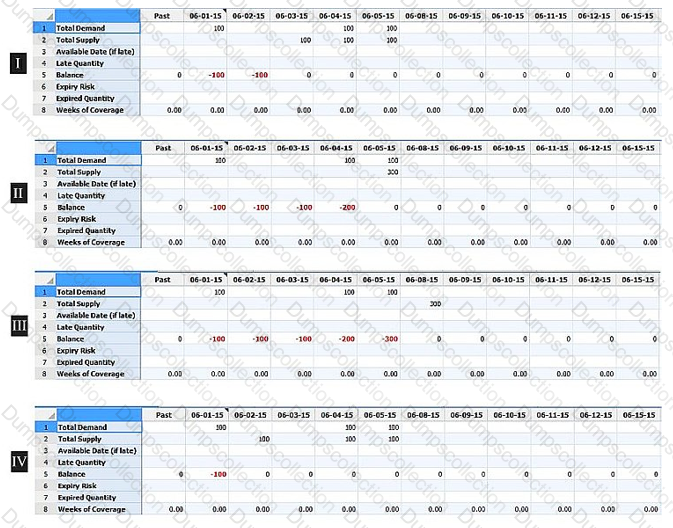Kinaxis Certified RapidResponse Author Level 3 Exam KX3-003 Exam Dumps: Updated Questions & Answers (December 2025)
You want to provide a worksheet based on the CRPOperation table to report destination location. There is only one valid stock location per operation. A secondary requirement is to view all valid work centers that feed a given stock location.
Which approach should you use to optimize performance?

A part has demands on 06-01, 06-04, and 06-05 as shown in the exhibit. The part source has this configuration:
OrderGenerationRule = 'AfterPTF'
LeadTime = 2 days
PTFRule = Lead
PlanningTimeFence = 2
Referring to the graphic, which table shows the resulting planned orders?
You need to create a new custom field to be used for record filtering that will be populated with the salesperson's name. Each order will have a single associated salesperson's name.
Following database design principles and Kinaxis best practices, which action accomplishes this task?
You are creating a metric worksheet to calculate the number of late orders for a specified time period. The metric worksheet will be based on the IndependentDemand table and it has two columns: DueDate and Count. The expression for Count is 1. The worksheet's filter expression is: DaysLate > 0 and Order.Type = 'Actual'.
In this situation, what is the column sequence and grouping properties for the metric worksheet?
You have a worksheet based on the Part table. You want to know the total number of unique customers that have orders for each part.
Which expression accomplishes this task?
A user wants to build a crosstab worksheet that shows historical data in daily buckets for the last two years. Currently, historical data is stored in days.
What are two ways to accomplish this task? (Choose two.)
Choose 2 answers
You are asked to transform PlannedOrder data into new ScheduledReceipt records, assuming just one PartSource per part and no maximum quantity. You need to filter the PlannedOrder records to ensure you do not try to create any ScheduledReceipt records which already exist. The workbook includes a worksheet, LKPScheduledReceipt, on existing converted ScheduledReceipts and follows Kinaxis best practices.
In this situation, which filter expression will follow KInaixs best practices and provide the best performance to include PlannedOrder records that do not match existing ScheduledReceipt records?
Customers sign in to view only their independent demands. The customer's User IDs are in a user group with the name of the customer to which they correspond. You want to create a single worksheet that allows customers to only view their independent demands within RapidResponse.
How would you accomplish this task?
You have defined a new namespace, TRM. You now want to define a new table that has a key reference field to the Mfg::ABCCode table. However, in the Add Input Field dialog,ABCCode does not appear.
What should you do to create the ABCCode key reference?
You have a hierarchy called PartFamily that is based on the PartCustomer table. There is a second hierarchy in use, also based on the PartCustomer table called PartPlanner. When the PartFamily hierarchy is used, performance is noticeably worse than when the PartPlanner hierarchy is used.
In this situation, which design issue would contribute most to poor performance?

